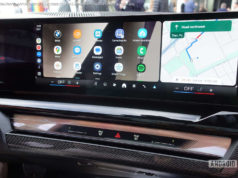According to our tests, the 2018 top-of-the line 13-inch Apple MacBook Pro is a highly capable video-editing or number-crunching platform, if not as fast as some competitors.
With the MacBook Pro’s 2018 13-inch and 15-inch refresh, Apple has focused almost exclusively on improving its flagship power laptop’s internal components, leaving the laptop’s exterior untouched save for some tweaks to the keyboard switches and the capabilities of the display panel. The big question is really all about speed this time around: How much of a performance boost can you expect from the new Intel quad-core and six-core eighth-generation “Coffee Lake” CPUs, their updated onboard Iris Plus graphics silicon, and other internal improvements?
As it turns out, in the early going, that was a loaded question, frought with some early ups and downs.
We subjected a maxed-out version of the new Touch Bar-equipped 13-inch MacBook Pro to our suite of benchmark tests to find out just how much faster (or slower) Apple’s latest hardware is compared with its predecessor and its Windows competition. We started that process on Friday, July 13. These 2018 MacBook Pros got off to a rocky performance start, though, in their first week of life, starting on that prescient date. (We’ll get into that in a moment.)
Apple loaned us a deluxe review unit of the 2018 Touch Bar MacBook Pro 13-incher; maxing out all the options means our review unit rings up at $3,699. You don’t have to spend that much on the $1,799 13-inch MacBook Pro base model, of course; our unit has the most expensive CPU, RAM, and storage options, more than doubling the price. It’s overkill for pretty much anyone save for data scientists, pro video editors, and those who can feed it tasks that lap up processor cores, available threads, and RAM. Specifically, to justify buying this machine as our tester is configured, you should expect to regularly max out the four cores and eight threads of the Intel Core i7-8559U, and have enough raw video footage or big enough datasets to fill the capacious 2TB SSD.
If this sounds like you, you’ll find the 13-inch MacBook Pro to be a capable implement, though certainly no jack of all trades. We pitted it against two of the 2017 MacBook Pros we tested, plus a mixed host of PCs. You’ll see pro content-creator laptops, to be sure, but also a beastly gaming machine for perspective, as well as models with some other late-model CPUs and GPUs, and two 2-in-1 detachable designs.
But first…about those early-on issues.
So, once we were briefed on the details of this patch, we downloaded the High Sierra patch immediately after its July 24 posting, and set to re-benchmarking.
The new bench results are an eye-opener.
For the TLDR version, here’s the summary of our sample system’s basic CPU testing numbers before and after the patch…
That’s one jagged-looking graph, with the clocks shooting up and down. The clock speeds, on average, would only briefly spike before throttling down to far less than its minimum capacity, then repeating the cycle over and over. It was a regular rollercoaster of clock frequency, not normal behavior. (We ran the same test on the 2017 dual-core version of this machine, and it showed a virtual flatline, by comparison.)
After the July 24 macOS update that tweaked the firmware, the CPU operation was far, far more stable…
We then re-ran the rest of our standard benchmarks to compare the performance with a host of other machines. Post-patch, the 2018 13-incher took just 1 minute even (1:00) to encode a four-minute HD video file into an iPhone-friendly format, again using Handbrake. That’s more than twice as fast as last year’s base-model 13-inch MacBook Pro with Touch Bar, and it’s even better than last year’s 15-inch MacBook Pro (1:06), which includes a more powerful processor and a dedicated graphics card.
Before we did the patch update on our 2018 test sample, this test took 1:11, so the update shaved off a whopping 11 seconds. That’s huge in a relative sense.
Some decidedly bigger Windows laptops we’ve tested in past weeks with the latest CPUs were significantly faster on this test. With its beastly Intel Core i9 processor, the Alienware 17 R5 gaming laptop accomplished the Handbrake conversion in just 48 seconds. The Dell XPS 15 2-in-1 was not far behind, with its unusual Intel Core i7 and AMD Radeon RX Vega “Kaby Lake G” combination eking out 57 seconds. (Note again, as we mentioned earlier, that the revamped 15-inch MacBook Pro is available with a Core i9 CPU as an upgrade, along with a dedicated Radeon GPU; we haven’t tested it yet.) But as you can see, the firmware update made a difference in closing the gap between our MacBook Pro 13-inch 2018 sample and the rest of this pack.
We saw a big change in the Cinebench score, too, after the patch. Before, the 2018 13-incher didn’t quite break 600. (It scored 597.) This again underscores the importance of installing Apple’s update.
When it comes to editing images in Photoshop CS6, one of the quintessential Mac computing tasks, the new MacBook Pro again showed itself vastly improved compared with last year’s model. It finished applying our lineup of 11 sample image filters in just 2 minutes and 35 seconds (2:35) after the July 24 patch, versus 2:43 before. That’s compared with 3:59 for the previous generation. Only the Alienware 17 R5 fared better in this lot, at 2:30.
With its Intel Iris Plus graphics silicon (part of the new Core i7 CPU), the 13-inch MacBook Pro offers better graphics performance than most ultraportables, which are equipped with lesser integrated Intel UHD Graphics silicon. This year’s chip recorded more than the 30 frames per second (fps) minimum for enjoyable gameplay on our Heaven and Valley simulations at Medium quality settings. This was after the July 24 patch; before it, these graphics tests stuttered enough that we didn’t deem the earlier numbers we got reliable, and indeed, they were the initial basis for our diagnostic back-and-forth with Apple.
The Iris Plus silicon is still integrated Intel graphics, of course, and not capable enough to play demanding games at HD resolution and topped-up settings, or to serve as a proficient accelerator for video-editing suites like Davinci Resolve. That’s evidenced by single-digit frame rates in the Heaven and Valley Ultra quality tests.
You can sidestep the measly frame rates of the Iris Plus by plugging in an external GPU ( eGPU), but the fact that Apple still doesn’t offer any form of discrete graphics chip on the 13-inch MacBook Pro is a touch disappointing, especially if you’re eyeing the top-of-the line version.






